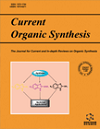- Home
- A-Z Publications
- Current Organic Synthesis
- Previous Issues
- Volume 20, Issue 3, 2023
Current Organic Synthesis - Volume 20, Issue 3, 2023
Volume 20, Issue 3, 2023
-
-
Recent Advances in Copper-Catalyzed Carbon Chalcogenides Cross- Coupling Reactions
More LessAuthors: Totan Roy, Atanu Mahata and Debasish KunduCu-catalyzed carbon-heteroatom bond formation is a powerful tool in the field of organic synthesis. In the past two decades, numerous Cu-based catalytic systems are developed in both homogeneous and heterogeneous forms. Important developmentshave been reported on Cubased catalytic systems in the field of C-Chalcogenide cross-coupling in the last few decades. Where homogeneous Cu/L-based catalytic syste Read More
-
-
-
Recent Developments in Multi-component Synthesis of Lawsone Derivatives
More LessBackground: 2-Hydroxy-1,4-Naphthoquinone (HNQ; Lawsone) is one of the most useful and the simplest naturally occurring naphthoquinones and has stimulated a resurgence of interest in the past decades due to a wide range of pharmacological activities. Introduction and Methods: This activity has led to the unusually large emphasis being placed on the design of more efficient multi-component reactions (MCRs) in the sy Read More
-
-
-
Palladium-Catalyzed Aminocarbonylation of Aryl Halides
More LessPalladium-catalyzed organic reactions are ubiquitous due to their high efficiency in coupling reactions and have wide applications in synthetic chemistry. Their widespread use in organic synthesis has been attributed to moderate conditions associated with reactions and tolerance to different types of functional groups. Palladium-catalysts are extensively used in aminocarbonylation of aryl halides for the synthesis of a Read More
-
-
-
Design and Facile Synthesis of Spiro-s-tetrazine Derivatives of 2,4- diphenyl-3-azabicyclo[3.3.1]nonane-9-one
More LessAuthors: Manini Nayak, Kanyanjali Samal and Anita PatiBackground: Literature survey suggested various methods of synthesis of the 3- azabicyclo [3.3.1] nonanes which include, Mannich reaction, α, α'-Annelation of Cyclic Ketones or through Enamines, Michael addition, Intramolecular Cyclizations, etc. However, a mechanism following a Michael addition path through the formation of the dibenzylidene cyclohexanone intermediate can not be ignored. Thus to ensure the mechanist Read More
-
-
-
Computational and Molecular Docking Studies of New Benzene Sulfonamide Drugs with Anticancer and Antioxidant Effects
More LessBackground: The studies on the potential usage of benzene sulfonamide derivatives as anticancer agents are limited. benzene sulfonamide derivatives are currently used as anticancer agents against different breast cancer cell lines, such as MCF-7, lung cancer cells (A549), prostate cancer cells (Du-145), and cervical cells (HeLa). Objective: A series of new sulfonamide drugs are synthesized by reacting aldehydes thio Read More
-
-
-
Discovery of Resveratrol and its Derivatives as Novel Antiviral and Anti- Phytopathogenic-Fungus Agents
More LessAuthors: Zongwei Xia, Xiuling Yu, Feng Feng, Pengfei Song, Wenqiang Yang, Jiacai Wang and Qingmin WangBackground: Plant diseases caused by viruses and pathogens have posed a serious threat to global agricultural production and are difficult to control. Natural products have always been a valuable source for lead discovery in medicinal and agricultural chemistry. The natural product resveratrol was found to have good antiviral activity against the tobacco mosaic virus (TMV) and fungicidal activities against 14 kinds of Read More
-
Volumes & issues
-
Volume 22 (2025)
-
Volume 21 (2024)
-
Volume 20 (2023)
-
Volume 19 (2022)
-
Volume 18 (2021)
-
Volume 17 (2020)
-
Volume 16 (2019)
-
Volume 15 (2018)
-
Volume 14 (2017)
-
Volume 13 (2016)
-
Volume 12 (2015)
-
Volume 11 (2014)
-
Volume 10 (2013)
-
Volume 9 (2012)
-
Volume 8 (2011)
-
Volume 7 (2010)
-
Volume 6 (2009)
-
Volume 5 (2008)
-
Volume 4 (2007)
-
Volume 3 (2006)
-
Volume 2 (2005)
-
Volume 1 (2004)
Most Read This Month
Article
content/journals/cos
Journal
10
5
false
en


